by Bryan Jáuregui, Todos Santos Eco Adventures
This article was originally published in Janice Kinne’s Journal del Pacifico
The American Cowboy is the quintessential symbol of what made America great: strong character, diverse skills, creative problem solving, resilient nature and beef on the table. The iconic cowboys loved their whiskey, played their harmonicas, and sported nicknames like Cactus Pete, Deadeye Jake and Kid Curry. But If you look under the buckskin a bit you’ll find that the original American cowboys likely preferred tequila, played bass fiddles, and had nicknames like El Coyote, Güero de las Canoas and Dos Santos Biel. And that’s exactly why Meg Glaser, Artistic Director of the Western Folklife Center in Elko, Nevada invited 5 Baja California Sur vaqueros (cowboys) to be the guests of honor at the 31st National Cowboy Poetry Gathering: they are the living link between the Spanish missionary soldiers that came to Baja California 300 years ago, and the American buckaroo. Yep, as surely as the Statue of Liberty came from France, and the melody of the Star-Spangled Banner came from England, the American Cowboy came from Mexico. Juan Wayne would have been a more apt screen name for the Duke.
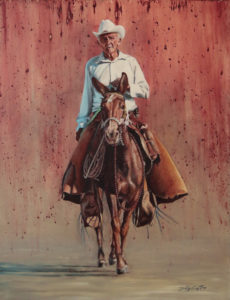
Don Jose y La Pancha. Painting by Carlos Cesar Diaz Castro
The Western Folklife Center (WFC) focuses on making connections with other horse and ranching cultures from around the world. They have hosted cowboys from the far-flung corners of the earth, including Mongolia, Hungary and Brazil, but nothing they had ever done prepared them for the challenge of hosting the vaqueros of Baja California Sur. Says Meg, “The BCS vaqueros live almost completely off the grid so they didn’t have passports, US visas, or even email access. It was incredibly challenging to get these men who live on roadless ranches, some of whom must ride 6 hours on mules to get to the nearest highway, from Baja to Nevada, but together with the great Baja team we did it and it was one of our most successful programs ever. Many of our buckaroos in Nevada and other parts of the west are pretty well versed on the history and the connection between the American cowboy and the Mexican vaquero, but very few of us realized that it was such a vibrant living culture. It was a real eye opener for all of us.”
Of course back in the day both Nevada and Baja were part of the Spanish California Provinces (Nevada in Alta or Upper California and present day BCS in Baja or Lower California) and cowboys and cattle – imported from Spain to satisfy the conquerors’ demand for beef – flowed freely throughout the region. In fact, the regions were so integrated culturally and linguistically that it wasn’t until the 1960s that people from Baja California were required to have a passport and visa to travel to the USA. The lingua franca of cowboys demonstrates the cultural link between the two Californias: “buckaroo” is the Americanization of the word “vaquero”, “chaps” comes from the Spanish word chaparreras, or leather leggings, “rodeo” comes from the Spanish word rodear, to surround, and “mustang” comes from the Spanish word mostrenco. The modern livestock industry in the USA continues to thrive on early Mexican techniques for handling cattle including branding, saddle cinching and using a hand-braided lariat – from the Spanish la reata – to rope cattle.
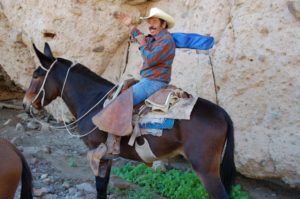
Chema with his guitar in the Sierras.Photo courtesy of Saddling South
But now there is most definitely a border, and crossing it was a tremendous experience for the whole team. Says vaquero Jose Maria Arce Arce, who goes by Chema, “Just imagine. I had to ride a mule for several hours out of the Sierras as part of the journey to the airport, then suddenly I was on a huge airplane and we flew over my ranch – I recognized it immediately and was amazed to see it from the air. This trip was my first time on an airplane and my first time in such a nice hotel. Imagine a horse that is accustomed to poor grazing areas then he’s put in a green pasture. That is what it felt like to me.” Trudi Angell has been Chema’s friend and business associate in the Sierra San Francisco since 2005, and she was the main organizer of the trip. The vaqueros nicknamed her “La Caponera” or “the bell-mare” of the trip: the one to follow. She sat next to Chema’s cousin, Bonifacio, or “Boni” on the first flight. “His eyes lit up like a kid as he turned around at lift-off and practically shouted “ ‘Chinga! The cars all look like ants!’ Forty minutes later when we flew over the Sierra San Francisco, Chema and Ricardo (Chema’s son who’s known as Teté) were pressed to the window pane and were practically beside themselves when they saw their ranch from the sky. It was a wonderful experience.”
Chema, Teté and Boni are Los Regionales de la Sierra, a musical group that plays traditional ranchero music from the northwest of Mexico, much of it resonant of eras long gone by. Chema plays accordion and guitar, Boni plays bajo sextoand accordion, and Tetéplays the northern ranchero bass fiddle. In Elko they performed often at schools, juvenile facilities and the Western Folklife Center itself, and were accompanied by singers Damiana and Duna Conde, daughters of the renowned Baja California Sur musician, comedian and political satirist Raul Conde. The crowds and other musicians simply couldn’t get enough of the group, and they were feted everywhere they went. Even Sourdough Slim, an acclaimed western singer who regularly plays the Lincoln Center and Carnegie Hall Folk Festival circuit invited the vaqueros to jam with him at the historic Pioneer Bar one evening. Observes Meg, “They were a smash sensation.”

Carlos’ stand up paintings of Boni, Chema and Tete. Part of the BCS exhibit.
The great reception to their musical skills wasmatched only by the tremendous enthusiasm for their skills as ranchers and craftsmen. Chema, Dario Higuera Meza and the other vaqueros met with American cowboys and shared information on ranching lifestyles, including working and breeding donkeys and horses. Says Chema of his American counterparts, “They are the same people that I am. I completely identified with them… the only difference is in the way they dance!” Dario, who is one of the few artisans left in BCS who knows how to create traditional ranch crafts using the old Baja California methods (he received an honorary degree from the Autonomous University of Baja California Sur in recognition of his unparalleled skills and contribution to BCS culture), gave daily demonstrations on horsehair rope making and leather braiding, and in particular bonded with several native American families over different methods of tanning and spinning rope. They were so enthralled with Dario they invited him to a Navajo festival. Chema’s nephew, Juan Gabriel Arce Arce – nicknamed Biel – gave daily demonstrations on leatherworking and other traditional ranch skills. Biel consistently wins the top prize at state-wide leatherworking contests.A traditionally tanned leather trunk that he made with ornately woven edges and beautiful hand tooling was purchased by a Basque ranching family from Elko for US$5,000.
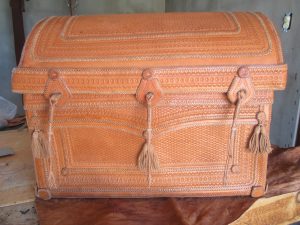
Biel’s Chest
McKenzie Campbell, one of the people responsible for getting the vaqueros to Elko, is the founder of Living Roots, a non-profit which helps BCS ranch families capitalize on their skills. At the request of the WFC gift shop, she made sure that the group brought many leatherwork pieces made by Teté, Dario, Biel and other ranchers, includingpolainas (leather gators), miniature vaquero saddles, belts and teguas (riding shoes). McKenzie also brought other BCS ranchero crafts including embroidered purses and bags, as well as tepetes, rag rugs that women make with scraps of cloth. It allsold like hot cakes in the gift shop.
The vaqueros are direct descendants of soldiers imported by the Jesuit missionaries in the 1700s. Recruited as part of a deal with the king of Spain that gave the Jesuits administrative autonomy in Baja California in return for protecting the territory from pirates, these “soldiers” were in fact largely people from Moorish Spain who had the excellent ranching and agricultural skills the Jesuits needed to develop their missions. They became known as the “soldiers of leather” to distinguish them from fighting “soldiers of metal”. When the Jesuits were subsequently kicked out of Baja, the “soldiers of leather” who worked the missions were given the lands by administrative fiat and from that point on Baja ranchero culture flourished. Largely forgotten by the rest of Mexico for several
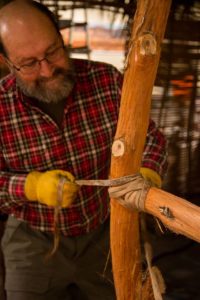
Fermin Building the Rancho Exhibit
generations and isolated by geography, the architecture, ranch tools, farm implements and cookware of BCS ranches remains to this day very similar to that developed by their Spanish forbears 300 years ago. “The BCS rancheros are a piece of the past that has survived until today” says Fermín Reygadas, a professor of Alternative Tourism at the Autonomous University of Baja California Sur who has worked with Baja Californiarancheros for over 30 years.
Fermín, who counts ranchers as some of his best friends in Baja, envisioned and happily executed the task of recreating a typical ranch dwelling with an hoja (palm-frond) roof and palo d’arco walls for the exhibit at the WFC. Working with La Paz artist Carlos César Diaz Castro in Elko a full month before the vaqueros arrived, Fermíncreated a truly astounding exhibit which everyone agrees captures the heart and soul of BCS ranchero life. Says Trudi, “The BCS exhibit was left up for 8 months and a woman from the WFC sent me a special note to say that the local folks from Elko came again and again to see the exhibit, bringing visiting friends and family. They had never seen this type of reaction to an exhibit before.”
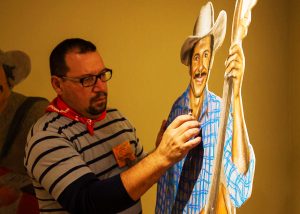
Carlos Painting Tete. Photo by Karla Fernanda Amao
The whole project got started when Rick Knight, a professor from Colorado State University and board member of the WFC, went on a mule trip with Trudi’scompany,Saddling South, in the Sierras. Chema was their guide at the Sierra San Francisco rock art sites, and he and his family entertained the group around the campfire at night. Rick informed Meg Glaser of the incredible experience he had had and in 2012 Meg came down to see it for herself. She knew right away she had to get the vaqueros to Elko.Three years later – which included intensive months of effort by Trudi in the quest for Mexican passports and US visas for 5 people who live almost completely outside the system (letters to the US Consulate from Nevada Senator Harry Reid, the BCS State Board of Tourism, the Western Folklife Center and several others all had to be obtained) – the group was in Elko. The connections made between people and cultures moved them all. Says Chema, “The best part is that we went so far and met people we had become friends with at the caves in the Sierras.” Says Meg, “The best part is that the social connections extend far beyond Elko and many people have already gone to Baja Sur to visit the Sierras and learn more about the vaquero culture.” Says Fermín, “The best part was watching the vaqueros bond with the US ranchers discussing knots and ropes, sharing ideas and experiences. It really showed how connected we all are.”For his part, Dario, who is not one of the musicians, had so much fun that he wrote a song about the whole experience.
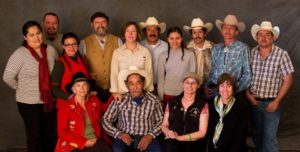
Elko Group Portrait Back Row, Left to Right: Karla Fernanda Amao (Carlos’s wife), Carlos Cesar Diaz Castro, Dune Conde, Fermin Reygadas Dahl, McKenzie Campbell, Chema (Jose Maria Arce Arce), Damiana Conde, Ricardo Arce Arce (Tete), Juan Gabrial Arce Arce (Biel), Bonifacio Arce Arce (Boni). Seated Front Row: Trudi Angell, Dario Higuera Meza, Teodora Montes Botham, Meg Glaser. Photo courtesy of Western Folklife Center.
Concludes Chema, “I never had a childhood because I’ve worked since I was a little boy. I now feel very proud that people know me and our life here at the ranch, both through the movie Corazon Vaquero and our trip to Elko. We represented the Baja California vaqueros to the cowboys of the US, and they really respect all the things we can do. It was a beautiful experience. But I’m still the same humble
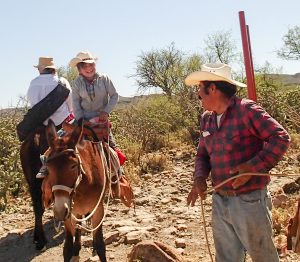
Chema and his grandaughter Azu. Photo courtesy of Saddling South
rancher I have always been and I haven’t changed my way of life. All of my grandchildren are becoming ranchers and I’m very pleased about that.” Fermín calls the vaqueros of BCS “an oasis of common sense humans.” Maybe Chema’s grandkids will be the next generation of Cowboy Ambassadors, connecting US cowboys to their living roots in Baja California Sur. Could there be another ride for the bell-mare? Possibly. Trudi says her first thought when she woke up after the trip to Elko was, “We have to take this show on the road!”
© Copyright Sergio and Bryan Jauregui, Casa Payaso S de RL de CV, 2016
